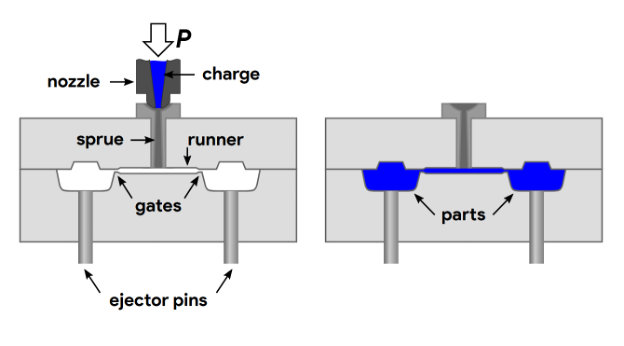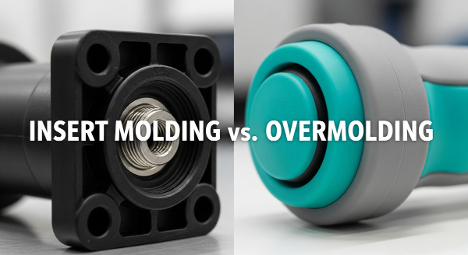Contents
In the intricate world of plastic injection molding, parting lines play an important role in determining the quality and functionality of the final product. Understanding the significance of parting lines can help achieve superior results in your plastic parts. This blog will delve into what parting lines are, why they matter, the types of parting lines, and how we manage them to ensure superior product outcomes.
What are Parting Lines
Parting lines are the lines or seams that appear on a molded part where the two halves of the mold (the core and the cavity) meet. During the injection molding process, molten plastic is injected into the mold, filling the cavity. Once the plastic cools and solidifies, the mold open, and the part is ejected. The junction where the two halves of the mold come together leaves a visible line on the finished product— this is the parting line.

The Significance of Parting Lines
While parting lines are a natual result of the injection molding proces, their presence and appearance can have significant implications:
1. Aesthetic Quality: For consumer-facing products, a visible parting line can affext the overall look and feel of the item. Products that require a smooth, uninterrupted surface must have minimal and inconspicuous parting lines.
2. Structual Integrity: In some cases, parting lines can be points of weakness, especially in parts that undergo stress of pressure. Ensuring that parting lines do not compromise the integrity of the part is crucial.
3. Functionality: For components that need to fit together precisely with other parts, parting lines must be controlled to prevent misalignment or improper fitting.
Types of Parting Lines
There are several types of parting lines, each suited to different molding requirements and product designs:
1. Straight Parting Lines: The most common type, straight parting lines, occur when the mold halves are perfectly aligned along a flat plane. This type is used for simple, symmetrical parts.
2. Stepped Parting Lines: Used for parts with complex geometry or varying wall thicknesses, stepped parting lines feature a step-like transition between mold halves. This design helps accommodate more intricate designs.
3. Curved Parting Lines: For parts with organic or curved shapes, curved parting lines follow the contours of the part. This type ensures a better aesthetic finish and minimizes visible seams on non-linear surfaces.
4. Interlocking Parting Lines: These parting lines are designed with interlocking features that help align the mold halves precisely. They are ideal for parts requiring high precision and tight tolerances.
5. Pinch Pating Line: Used when molding thin or flexible areas, pinch parting lines involve a slight overlap where the mold halves meet, ensuring a secure and well-defined seam.
Factors Influencing Parting Lines
Several factors can influence the formation and appearance of parting lines in injection molding:
1. Mold Design: The design and construction of the mold play a pivotal role. Well-designed molds with precisely aligned halves produce cleaner and less noticeable parting lines.
2. Material Selection: Different plastics behave differently during the mold process. The type of plastic used can affect how noticeable the parting line is.
3. Injection Parameters: Variables such as injection pressure, temperature, and cooling rates can influence the appearance of the parting lines.
Managing Parting Lines at HordRT
At HordRT, we empoly several strategies to manage and minimize parting lines, ensuring the highest quality of molded parts:
1. Advanced Mold Design: Our experienced engineers utilize state-of-the-art CAD software to design molds that minimize parting lines. Precision in mold alignment is key to achieving seamless parting lines.
2. Material Expertise: We select the most appropriate materials for wach project, considering how different plastics will interact with the mold and the final product requirements.
3. Optimized Process Parameters: By carefully controlling injection molding parameters, we can influence the formation of parting lines. Our technicians continuously monitor and adjust these parameters to achieve the best results.
4. Post-Molding Process: In some cases, post-molding processes such as triming, polishing, or coating can be employed to further reduce the visibility of parting lines.
Conclusion
Understanding and managing parting lines s crucial for producing high-quality plastic parts. At HordRT, we pride ouselves on our meticulous attention to detail and our commitment to excellence in injection molding. By focusing on the factors that influence parting lines and employing advanced techniques to minimize their impact, we deliver products that meet and exceed our clients' expectations.
Whether you're developing a new product or improving an existing one, our team at HordRT is here to help you navigate the complexities of plastic injection molding. Contact us today to learn more about our services and how we can support you next project.
-q4gvl4k29y4hq8j9rjpapvj0ft06fje63olt7p210i.png)


